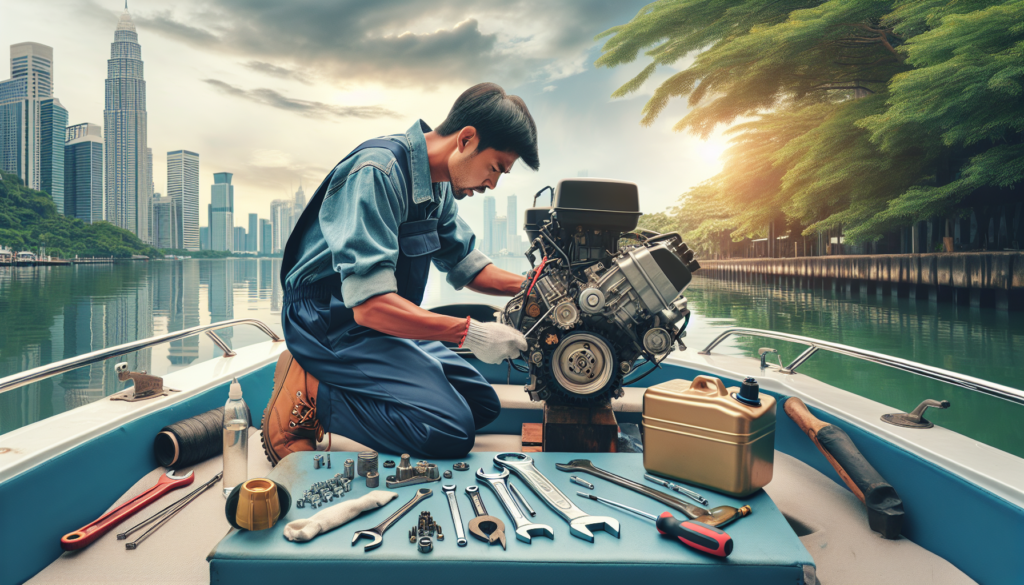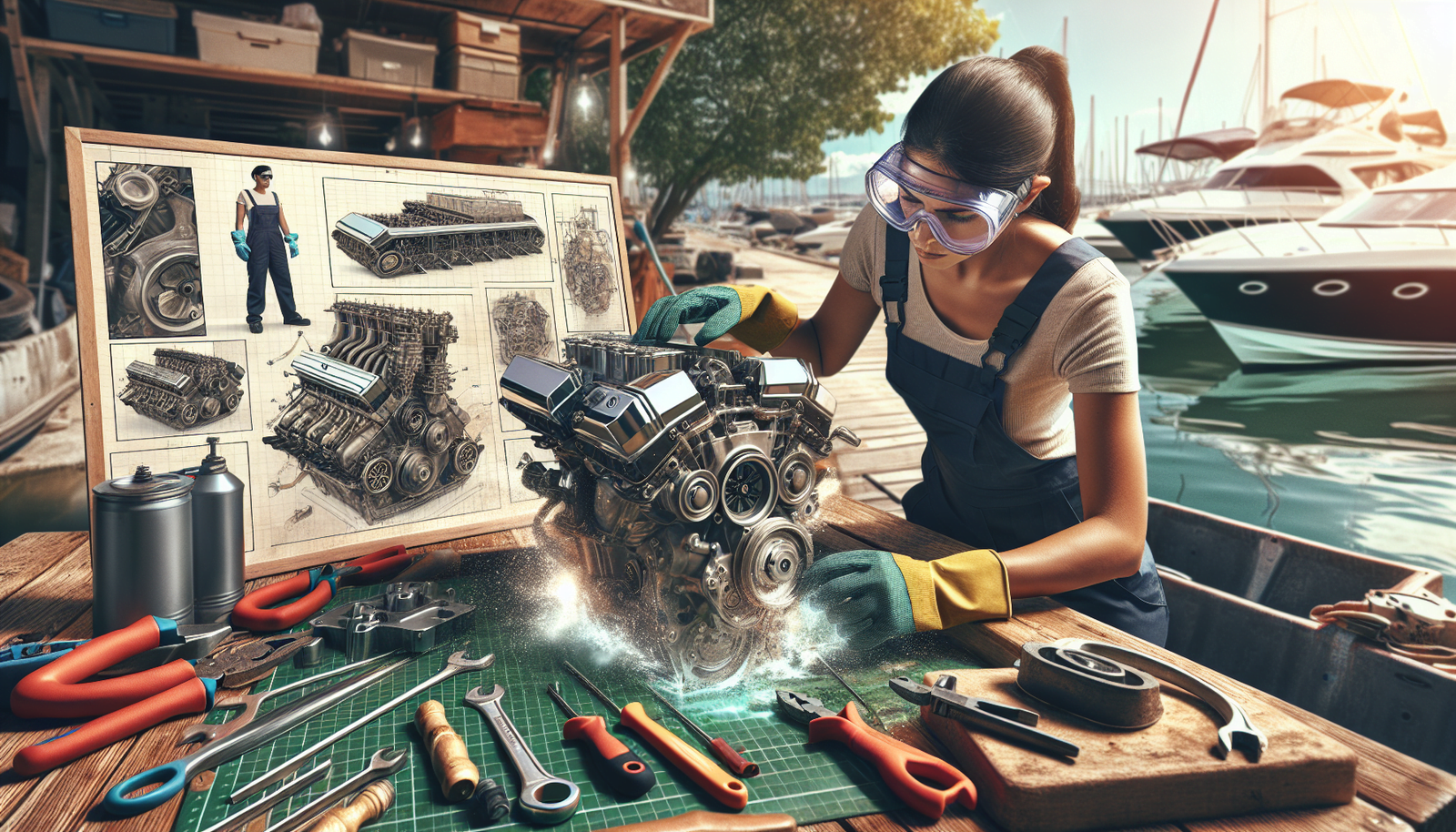Are you a boat owner wanting to maintain your vessel in top shape without relying on costly professionals? If so, “DIY Boat Engine Maintenance for Smooth Operation” is for you. This comprehensive guide tells you everything you need to know about maintaining your boat’s engine. Most importantly, it’s a do-it-yourself approach which means big savings on labor costs. It doesn’t matter if you’re a seasoned sailor or a newbie to the nautical world, this step-by-step manual provides you with hands-on information to keep your boat running smoothly, ultimately guaranteeing an enjoyable and worry-free seafaring experience.

Importance of Regular Boat Engine Maintenance
Keeping your boat in excellent working condition is key to the enjoyment you get from your time out on the water. Regular boat engine maintenance not only ensures your safety at sea, but it could also save you the high cost of big repairs down the line.
Understanding the Basics of Boat Engine
Your boat’s engine is its heart. Like human hearts, engines need care to function efficiently. It’s essential to understand the basics of your engine, such as its specifications, top speed, horsepower, fuel capacity, and any particular needs it might have for high performance. For example, some engines need specific oils, fuels, or replacement parts to run smoothly.
Why Regular Maintenance is Crucial
Regular maintenance is vital to extending the life of your boat engine and keeping it running at its most efficient. From changing the oil to checking the fuel system, there’s a lot of minor things that go a long way toward preventing major issues in the future. Regular maintenance keeps pricey repairs at bay and ensures your boat will be ready when you need it.
Impact of Neglected Maintenance on Boat Performance
Neglecting regular maintenance can lead to a slew of problems, including engine failure, poor fuel efficiency, and even irreparable damage. Regular facilities check will help in spotting potential trouble spots early before they become serious problems. Hence, preventing a little problem from becoming a bigger one.
Understanding Boat Engine Components
By understanding the components of your boat’s engine, you’ll have a better idea of what sort of maintenance is required and when it needs to be done.
Types of Boat Engines
There are various types of boat engines, mainly ranging from outboard motors to inboard motors. Each type accentuates different maintenance needs, and being familiar with yours can help you maintain it effectively.
Major Components of a Boat Engine
A fundamental understanding of the major components of a boat engine, such as the cylinder block, pistons, valves, and fuel system, will help you carry out effective check-ups. Some parts, like spark plugs and filters, should be replaced at regular intervals, while others can last the lifetime of the engine, granted they’re properly cared for.
How Boat Engine Operates
Understanding how your boat engine operates can significantly help you learn the maintenance needs. Know when it’s normal or when it’s sounding or acting differently. Being sensitive to the signals your boat is giving you can help you catch issues earlier.
Routine Inspection of Boat Engine
Routine inspection of your boat’s engine is a fundamental part of ongoing maintenance.
Frequency of Inspection
Most experts recommend inspecting your boat engine before and after every trip, along with a thorough inspection at the start and end of boating season. *This will ensure that any potential issues are identified and addressed promptly, maintaining the boat’s performance and longevity.
Self-inspection vs Professional Inspection
While self-inspection is essential for regular maintenance, professional inspections are just as crucial. A professional is trained to spot issues you might miss. Additionally, your boat might require certain tools or knowledge that only a professional might have. Therefore, it’s advisable to balance both.
Key Elements to be Checked During Inspection
During an inspection, you should check the oil levels, cooling system, propeller, fuel system and more. Be sure to look for common problems like leaks, wear and tear, and broken parts.
Learn to Change Engine Oil and Filter
Changing the engine oil and filter is one of the most basic yet essential maintenance tasks.
Conducting Engine Oil Check
Before you change the oil, you have to check it first. Using a dipstick, you can easily check the oil level in your engine. This should ideally be done before every trip to ensure that the engine oil is at its required level.
Steps to Change Boat Engine Oil
Changing the boat engine oil involves draining the old oil, replacing it with the new oil, and ensuring that it is at the recommended level. Ensure you dispose of the old oil responsibly as it could harm the environment.
How and When to Replace Oil Filter
The oil filter should be replaced every time you change the oil. It’s advisable to replace it beforehand to ensure it’s drawing out any contaminants from the new oil.

Fuel System Maintenance
Maintaining your fuel system is just as important as maintaining your engine oil.
Understanding the Fuel System
The fuel system consists of the fuel tank, fuel pump, carburetor, and fuel lines. Its main job is to store and supply fuel to the engine. Understanding how each component works can help you maintain it.
Checking and Cleaning the Fuel Lines
To prevent any blockages in the fuel system, it is important to routinely check and clean the fuel lines. This can be done by visually inspecting the lines for any signs of wear and tear and by feeling them for any obstructions.
Replacing the Fuel Filter
Just like the oil filter, the fuel filter helps remove any contaminants in the fuel before it reaches the engine. It needs to be replaced at least once a year or after every 100 hours of engine operation.
Maintaining the Fuel Tank
Maintaining your fuel tank involves keeping it clean and free from any debris. Regularly remove and dispose of any water or dirt that may accumulate inside.
Care and Maintenance of the Propeller
The propeller plays a vital role in driving the boat forward. It needs regular maintenance to keep it functioning with its maximum efficiency.
Importance of Propeller Maintenance
A properly maintained propeller ensures excellent boat performance, fuel efficiency, and longevity. A damaged or worn-out propeller can lead to increased fuel consumption and poor boat handling.
How to Check the Propeller
You should routinely check your propeller for any signs of damage such as dents, cracks, or bends. Look out for any fishing lines that might be wrapped around the propeller shaft.
Repairing and Replacing the Propeller
Any damage to your propeller needs immediate attention. Minor damages might be repaired, but significant damages will require replacements.
Cooling System Maintenance
The cooling system plays a vital part in preventing your engine from overheating.
Understanding the Cooling System
The cooling system, primarily composed of water pumps and thermostats, helps regulate your engine’s temperature and prevents it from overheating. Understanding how your cooling system functions can help you maintain it properly.
Cleaning and Flushing the Cooling System
To ensure that your cooling system is working properly, it needs to be cleaned and flushed on a regular basis. This can be achieved using fresh water and specific engine cleaning products.
Troubleshooting Common Cooling System Issues
Common cooling system issues include leaks, clogged passages, and faulty water pumps. Each of these issues can be avoided through regular maintenance and inspections.
Electrical System Inspection and Maintenance
Your boat’s electrical system powers everything from your lights to your engine’s spark plug. Its performance is vital for your safety and comfort.
Basic Boat Electrical System Overview
The basic boat electrical system includes a battery, a charging system, and a network of wiring. The battery powers the electrical equipment, the charging system powers the battery, and the wires transmit electricity.
Routine Electrical System Checks
An essential part of maintaining your boat’s electrical system includes routine check-ups. This includes checking the battery, wiring, and charging system.
Repairing or Replacing Electrical Component
If any part of your electrical system is damaged or not working correctly, repairs should be made immediately. Some repairs can be DIY, while others may require a professional’s help due to the complex nature of electrical systems.
Belt and Hose Maintenance
Boat engine belts and hoses also need routine inspection and maintenance due to their crucial role in the functioning of the boat engine.
Purpose and Function of Belts and Hoses
Belts and hoses are key in many engine processes, including cooling, charging, and water circulation. Their condition can affect the engine’s performance overall.
Monitoring the Condition of Belts and Hoses
Due to their crucial role, belts and hoses need to be monitored constantly for signs of wear and tear, such as cracks, leaks, or loss of tension.
Replacing Worn-out Belts and Hoses
Depending on their condition, it is crucial to replace worn-out belts and hoses. Failure to do so can lead to engine complications, such as overheating or a dead battery. Replacement intervals depend on the condition of these items and may differ from boat to boat.
Winterization of Boat Engine
Winterization is another aspect of boat maintenance that demands your attention, as neglecting it could result in significant damage to your boat engine.
What is Winterization
Winterization is preparing your boat for storage during winter. This entails a range of tasks such as drainage and flushing of engines, protecting the electrical system, and thorough cleaning before storage.
Harshness of Winters on Boat Engine
Winter weather can be especially harsh on your boat engine. The cold can cause internal components to contract and damage, and any moisture in the systems may freeze and create issues.
Steps for Effective Winterization
Effective winterization involves draining the engine, applying a layer of corrosion protector, fogging the engine cylinders, and stabilizing the fuel. It’s also advisable to remove the battery, charge it and store it in a warm, dry place.
In conclusion, remember that maintenance is key to the smooth operation of your boat engine. The time you devote to regular checks and repairs will pay off in long-term efficiency and fewer breakdowns, providing you with an excellent boating experience.

